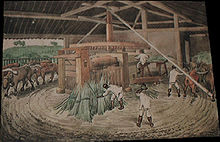Hércules Florence
This article needs additional citations for verification. (June 2007) |
Antoine Hercule Romuald Florence (February 29, 1804 – March 27, 1879) was a Monegasque-Brazilian painter and inventor, known as the isolate inventor of photography in Brazil, three years before
Early life
Hercules Florence was born on February 29, 1804
After a period of wandering and working on board of
The great expedition

Florence's life changed dramatically when he decided to respond to a newspaper advertisement put by
Businessman and inventor
Soon after the end of the expedition, in 1830, Florence married Maria Angélica de Vasconcellos, the daughter of his acquaintance and benefactor Francisco Álvares Machado, and went to live with her in the city of

Soon after settling in Campinas, Hércules Florence began a prolific career as inventor and businessman. During the Langsdorff expedition, he had developed a new system of using
In 1832, with the help of a pharmacist friend, Joaquim Correa de Mello, Florence began to study ways of permanently fixing camera obscura images, which he named "photographia". In 1833, they settled on silver nitrate on paper, a combination which had been the subject of experiments by Thomas Wedgwood around the year 1800. Unlike Wedgwood, who was unable to make photographs of real-world scenes with his camera or render the photograms that he did produce light-fast, Florence's notebooks indicate that he eventually succeeded in doing both.[8] Unfortunately, partly because he never published his invention adequately, partly because he was an obscure inventor living in a remote and undeveloped province, Hércules Florence was never recognized internationally as one of the inventors of photography. He died in Campinas, Brazil.[9]
A photographic image of several pharmaceutical flask labels, produced by Hercules Florence in
Cultural references
A film documentary, featuring Adriana Florence, a grand-grand-granddaughter of Hércules Florence living in Campinas, Brazil, has been made by the Discovery Channel and retraces part of the Baron von Langsdorff expedition's itinerary. It also visited the St. Petersburg's Langsdorff museum collections. The director was Mauricio Dias.
- Tras las Huellas de la Expedición Langsdorff. Discovery Channel in Spanish.
Bibliography
- Florence, Hércules. Voyage fluvial du Tieté à l'Amazone, published in Portuguese as Viagem Fluvial do Tietê ao Amazonas. Hércules Florence, Brazilian edition with translation by Francisco Álvares Machado and Vasconcellos Florence, Museu de Arte de São Paulo Assis Chateaubriand, 1977.
- Vieillard, J.: A Zoophonia de Hercule Florence. Editora da Universidade de Mato Grosso, Cuiabá, 1993.
- William Luret: "Les trois vies d'Hercule Florence", éditions JC Lattès, Paris 2001
- Kossoy, Boris: "Hercules Florence, o pioneiro da fotografia no Brasil",O Estado de S.Paulo, Suplemento Literário,São Paulo,1973.
- Kossoy, Boris: Hercule Florence: "Pioneer of photography in Brazil", Image, 20 (1) Rochester, International Museum of Photography at George Eastman House, March 1977.
- Kossoy, Boris: The pioneering photographic work of Hercule Florence, New York/London, Routledge, 2018.
- Kossoy, Boris: Hercule Florence: A descoberta isolada da fotografia no Brasil, 3ed., Editora da Universidade de São Paulo - Edusp, São Paulo, 2006 (1st ed. 1977).
- Kossoy, Boris: Hercule Florence: La découverte isolée de la photographie au Brésil, Paris, l'Harmattan, 2017.
- Kossoy, Boris: Hercule Florence: el descubrimiento aislado de la fotografía, Madrid, Cátedra Ed., 2017.
- Kossoy, Boris: Hercule Florence: die entdeckung der fotografie in Brasilien, Vienna, Lit Verlag, 2015.
- "Sobre". Instituto Hercule Florence. Retrieved 8 September 2022.
- Wanderley, Andrea (7 March 2018). "O francês Hercule Florence (1804 – 1879), inventor de um dos primeiros métodos de fotografia do mundo". Brasiliana Fotográfica. Retrieved 8 September 2022.
References
- ^ "Hercule Florence. Le Nouveau Robinson". Nouveau Museé National de Monaco (in French). Retrieved April 17, 2024.
- ISBN 968-03-0020-X.
- ^ John Hannavy (ed.), Encyclopedia of nineteenth-century photography: A-I, index, Volume 1, Routledge, 2008, p. 536.
- ^ "About Hercule Florence". Hercule Florence Institute. Retrieved April 17, 2024.
- ^ "One of Photography's Earliest Inventors Had an Ingenious Trick to Stop His Images From Over-Developing, Scholars Say". Artnet. Retrieved April 17, 2024.
- ^ "Hercules Florence, Inventor of Photographia". ArtForum. Retrieved April 17, 2024.
- ^ "Hercule Florence". Enciclopédia Itaú Cultural (in Brazilian Portuguese). Retrieved April 17, 2024.
- ^ "Hercule Florence". Google Arts and Culture (in Brazilian Portuguese). Retrieved April 17, 2024.
- ^ "Hercule Florence". Instituto Moreira Salles (in Brazilian Portuguese). Retrieved April 17, 2024.
- ^ "Hercule Florence – Apresentação". Instituto Moreira Salles. Retrieved Jan. 17, 2018. (in Portuguese)
External links
- Dicionário das Artes Visuais (in Portuguese)
- Documents and publications about Hercule Florence at Instituto Hercule Florence's Corisco IHF database

